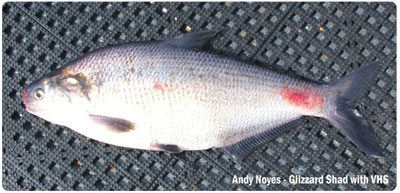
Viral Hemorrhagic Septicemia (VHS) is a deadly fish virus, first discovered in the Great Lakes. Vermont has adopted regulations to prevent the introduction of VHS to our waters.
Viral hemorrhagic septicemia (VHS) is considered to be one of the most serious diseases of trout and salmon in freshwater environments in Europe. Outbreaks of the VHS virus can result in severe fish mortality events in commercial aquaculture practices as well as in wild populations, and can often have serious socio-economic consequences. For these reasons, VHS is listed as a reportable disease by the World Organization for Animal Health (OIE).
Fish infected with VHS may exhibit minor external hemorrhaging in the form of red pin-point spots or larger patches, particularly around the head. However, some infected fish may not exhibit any external signs at all. Internally, organs often display multiple hemorrhages, particularly in the liver, spleen, intestines and swim bladder. Sick fish often appear lethargic, swim in circles, or lie motionless just below the water surface. Although not all infected fish develop the disease, they can be carriers and have the ability to spread the disease to other fish.
How did VHS arrive in the Great Lakes?
Scientists are not sure how the virus arrived in the Great Lakes. Like many Aquatic Invasive Species, it may have been introduced through infected fish or water dumped from the ballast tanks of ships from Europe. It may have arrived through infected fish migrating from the Atlantic Coast.
Where is VHS currently found?
From the time it was first discovered in Lake Ontario in 2005, the VHS virus has spread rapidly to other Great Lakes and inland waters. The most probable way the virus moved through fish populations in the Great Lakes is through natural movement of infected fish.
The virus most likely spread from the Great Lakes to inland waters through the capture and movement of live fish such as baitfish, and the transfer of contaminated water from one waterbody to another.
Although VHS has not yet been discovered in Vermont, the chance of it being spread here through live fish and overland boat movement is very real!
What species of fish does VHS affect?
VHS is not a threat to people who handle or eat infected fish. However, it does pose a real threat to the many species of Vermont fish it can kill. There are 37 fish species known to be susceptible to the VHS virus, 26 of which are found in the Great Lakes.
There are 24 species in Vermont that are susceptible to this fish disease. New fish species are being found that can carry the virus each year.
Black crappie Pomoxis nigromaculatus*
Bluegill Lepomis macrochirus*
Bluntnose minnow Pimephales notatus*
Brown bullhead Ictalurus nebulosus*
Brown trout Salmo trutta*
Burbot Lota lota*
Channel catfish Ictalurus punctatus*
Chinook salmon Oncorhynchus tshawytscha
Cho salmon Oncorhynchus kisutch
Emerald shiner Notropis atherinoides*
Freshwater drum Aplodinotus grunniens*
Gizzard shad Dorosoma cepedianum*
Largemouth bass Micropterus salmoides*
Muskellunge Esox masquinongy*
Northern pike Esox lucius*
Pumpkinseed Lepomis gibbosus*
Rainbow trout Oncorhynchus mykiss*
Redhorse sucker Moxostoma spp*
Rock bass Ambloplites rupestris*
Round goby Neogobius melanostomus
Smallmouth bass Micropterus dolomieu*
Walleye Sander vitreus*
White bass Morone chrysops
White perch Morone americana*
Whitefish Coregonus spp*
Yellow perch Perca flavescens*
Spottail shiner Notropus hudsonius*
Trout-perch Percopsis omiscomaycus*
* = Species known to occur in Vermont
How is the VHS virus spread to new waters?
The VHS virus is readily transmissible to fish of all ages, and survivors of infection can become lifelong carriers. The virus is shed from infected fish in urine, feces, and reproductive fluids, and transmission can occur through the water or by direct contact with infected fish, or contact with infected equipment.
The virus can persist in water in an infective state without a fish host for up to 14 days. It has also been documented that the virus is not always killed by freezing infected fish. In a hatchery or fish holding facility, transfer of the VHS virus on contaminated surfaces of gear and equipment presents a substantial hazard.
Healthy fish can also be infected when they eat an infected fish. Infected fish and water can easily spread the virus if they are released into a new water body. It is important that anglers, boaters and other water users do not move fish and water from one waterbody to another.
Can birds spread the VHS virus to new waters?
VHS cannot be transmitted through the feces of birds that eat infected fish since the virus cannot survive being passed through a birds' digestive system. Studies in Europe have shown that the European strain of VHS can survive on the feathers or feet of birds that have come in contact with infected fish or water. However, this method of spread is unlikely as it would take many trips of birds between infected and uninfected waterbodies to transfer and create the concentrations of the virus needed in the water to infect fish.
What can I do about VHS?
Help stop the spread of invasive species and fish diseases. Understand and follow all Fish & Wildlife regulations pertaining to baitfish use, fish importation and fish movement.
Inspect your boat, trailer, and all equipment and remove any visible aquatic plants, animals, and mud.
- Drain all water from your boat, motor, bilge, live wells, and bait containers before leaving the waterbody.
- Do not move live fish, including baitfish, from one water to another.
- Never leave waters with any live fish or fish eggs. The department recommends that leftover baitfish be killed and discarded on the ice or in the water prior to leaving the waterbody.
- Buy your baitfish from licensed Vermont bait dealers.
- Wash your boat and equipment with high pressure or hot water, or let it dry for five days between waterbodies.
See also:
New York Department of Environmental Conservation - VHS in New York
Wisconsin Department of Natural Resources - VHS Information
